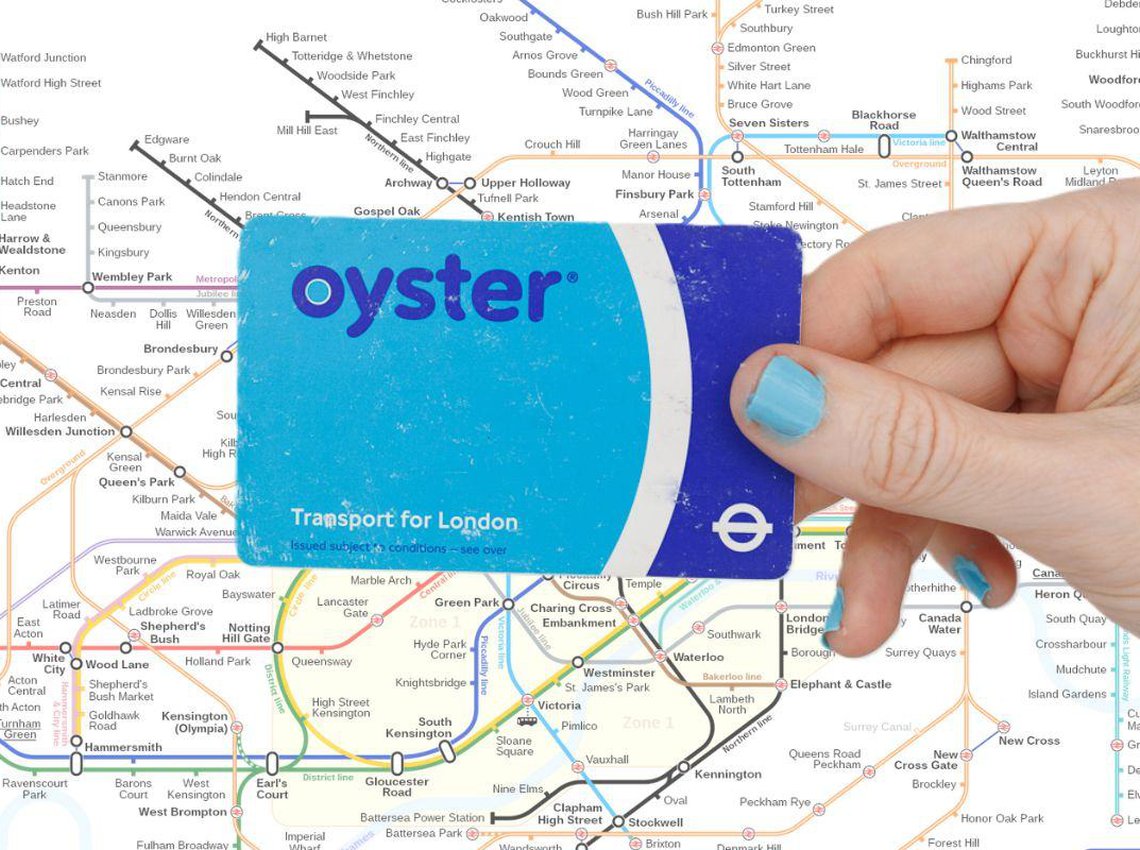
The Ultimate Guide to Oyster Cards for Students in 2025
Moving to a new country for studies is an exciting chapter in life, but navigating unfamiliar transport systems can feel overwhelming. For students coming to London, having access to efficient and affordable transportation is crucial. This can be a convenient option for commuting to classes, exploring the city, and managing daily life. This is where the Oyster Card becomes a game-changer.
The Oyster Card is a smart, reusable travel card designed to simplify public transportation across London. It offers unmatched convenience, significant cost savings, and ease of access to the city’s extensive transport network. The Oyster Card is an indispensable tool that integrates seamlessly into student life – be it hopping on the Tube, boarding a bus, or taking the Overground.
This guide is designed for you, international students like yourself, to navigate London's transport system with ease. Whether you want to learn about getting a student Oyster card and how to understand the discounts, fares, and travel zones, we've covered it all. From handy tips to solutions to frequent problems and insights into sustainable travel, this guide ensures that transportation in London will not be one of those worries you have as you settle into your new home.
What is an Oyster Card?
The Oyster Card is a travel smart card developed by Transport for London (TfL). It was introduced with the sole motive to simplify access to London’s public transport system. It acts as a digital wallet for the users, allowing them to travel across the city without needing paper tickets. The Oyster Card is both time-saving and cost-efficient for users with its tap-in, tap-out functionality.
The Purpose
The Oyster Card is meant to make transportation across London seamless, be it on buses, the Tube, trams, Overground, DLR, or some National Rail services. Its purpose is primarily to streamline the payment process. This also gives residents pay-as-you-go functionality, capped daily fares, and reduced rates compared to single paper tickets.
Different Types of Oyster Cards
You can choose from several types of Oyster Cards based on your needs:
Standard Oyster Card
This is a pay-as-you-go card for people living in London or who travel there often. You top it up with money, and then you use it to travel on buses, trains, tubes, and trams around London. This is the most flexible of all, as it does not commit you to paying a certain amount monthly or annually and can be topped up as and when you require it.
Visitor Oyster Card
This one is designed with tourists in mind. This card works similarly to the Standard Oyster Card but offers additional benefits. Along with discounted travel on public transport, it provides access to exclusive deals at popular London attractions, restaurants, and shops. This card can be pre-purchased before arriving in London, which offers great convenience for tourists.
Student Oyster Card
Since this card was designed for full-time students in London, it offers huge travel discounts to the holder. Students may benefit from a reduced cost for travel passes, so it is very economical if one needs to travel across the city on a frequent basis. To qualify, the students should be enrolled in a course lasting 14 weeks or more.
Zip Oyster Card
This is a card for children, aged 5-12, and teenagers, aged 13-17. They are free or very cheap to travel on public transport in London. These discounts and offers vary with age and eligibility.
Senior Oyster Card
This is a great option available to residents aged 60 and above. This card helps older residents save money on their daily travel needs, with discounted rates for bus, tube, and tram journeys, as well as extra travel benefits tailored to senior citizens.
How to Get an Oyster Card for Students?
A Student Oyster Card is a must-have for students in London. It offers discounted travel and makes daily commutes more affordable. Here’s how you can apply for one efficiently.
Eligibility Criteria of an Oyster Card
To apply for a Student Oyster Card, you must meet the following requirements:
- Be 18 or older.
- Enrolled in a full-time course lasting at least 14 weeks at a recognised institution in London.
- Reside in London or regularly commute to the city for your studies.
[Students on eligible part-time apprenticeships may also qualify.]
How To Apply for a Student Oyster Card?
The process can be completed either online or offline.
Online Application for a Student Oyster Card
Step 1: Visit the official TfL Oyster Card Student Section and register.
Step 2: Complete the online form with your personal details, course information, and address.
Step 3: Upload supporting documents, including proof of enrolment and a valid photo ID.
Step 4: Pay the £20 non-refundable application fee.
Step 5: Submit your application and wait for confirmation. Once approved, your card will be mailed to you within 10 working days.
Offline Application for a Student Oyster Card
Step 1: Collect a paper application form from your institution’s student services.
Step 2: Complete the form and attach the required documents, such as proof of enrolment and photo ID.
Step 3: Submit the form via your institution, paying the £20 application fee during submission.
Documents Required for Student Oyster Card
Whether applying online or offline, ensure you have:
- Proof of enrolment (e.g., a letter from your institution or student ID).
- Valid photo ID (passport or driver’s license).
- A passport-sized photo for offline applications (if required).
Follow these steps to prepare yourself to use your Student Oyster Card and navigate London's transport system effortlessly and affordably.
Oyster Card Student Discount
The 18+ Student Oyster photocard is a great assistance to students in navigating through the transport system of London. Its variety of benefits and discounts make it an easy means of travelling and staying in the city, despite academic and personal life stresses.
What is the 18+ Student Oyster Photocard?
The 18+ Student Oyster Photocard is a specialised version of the Oyster Card designed for full-time students aged 18 or older. It gives access to considerable travel discounts and therefore it helps save money on daily commutes and weekend explorations. The photocard has your photograph printed on it and is non-transferable.
Benefits of the Student Oyster Card
Using the Student Oyster Photocard, students can enjoy:
30% Discount on Travelcards and Bus & Tram Passes: Unrestricted travel within designated zones, which are excellent options for students travelling to class frequently.
Daily and Weekly Fare Caps: This facility makes sure you don't pay for the commute above a specific limit. Especially in case of multiple trips within the day or week.
Seamless Travel across Modes: From buses to the Tube, Overground, DLR, and National Rail services in London.
Cost Efficiency: Compared to single-fare payments, students save significantly over time.
How Does It Compare to Other Travel Discount Cards?
Other travel discount cards in London come in handy along with the 18+ Student Oyster photocard, depending on individual circumstances.
Card Type | Target Group | Key Benefits |
18+ Student Oyster Card | Full-time students | 30% discount on Travelcards and passes, ideal for frequent commuters. |
16-25 Railcard | Ages 16-25 or students | 1/3 off National Rail fares; can be linked to an Oyster Card for added savings. |
Visitor Oyster Card | Tourists | Pay-as-you-go with capped fares; additional discounts at attractions. |
Standard Oyster Card | General public | Flexible pay-as-you-go option with daily caps, no student-specific discounts. |
For most students, the 18+ Student Oyster photocard stands out as the best option, especially for regular travel within London.
The Student Oyster Card discount isn’t just a financial advantage; it’s a gateway to exploring the city without worrying about transportation costs in London.
How to Top Up Your Oyster Card
Topping up your Oyster Card is a straightforward process. It offers you, as a student, multiple convenient options to ensure their travel funds are always available. Here’s everything you need to know about managing your card balance effectively.
Methods to Top Up Your Oyster Card
Managing your daily commute or trips for study sessions can get a lot smoother when you learn how to easily top up your Oyster Card. This can be when you are travelling across London or just hopping between stops in your neighbourhood, topping up will ensure that you never have to stop short in your travels.
Online Topping Up
Add credit to your Oyster Card directly from your home or even on the go and save your time.
Step 1: Log in to your account on the TfL Oyster Portal.
Step 2: Select the top-up option and choose your desired amount.
Step 3: Your balance will update after you tap your card on a reader during your next journey.
Pro Tip: Enable notifications to remind you when your balance runs low.
At Stations
Just ideal for last-minute needs, station machines are convenient and fast.
Step 1: Use the self-service ticket machines available at most Tube, Overground, and DLR stations.
Step 2: Insert your card, select the top-up amount, and pay using cash or card.
Step 3: Your balance is updated instantly. You can check it on your phone or directly use the card.
Retail Outlets
For those who prefer face-to-face transactions over the above, local shops are always good.
Step 1: Many newsagents and convenience stores display the Oyster Card logo and can top up your card.
Step 2: Simply hand over your card and payment to the cashier..
What is the Auto Top-Up Feature?
For busy students, the auto top-up for Oyster Card feature is a lifesaver. This is especially valuable for students with hectic schedules who would like to spend all their time on studying and other activities without disruptions by traveling.
Step 1: Link your bank card to your Oyster Card through your online TfL account.
Step 2: Set a trigger amount (e.g., £10). Whenever your balance drops below this, it will automatically top up by a pre-set amount.
Step 3: Benefits include never running out of credit and avoiding delays during commutes.
Tips for Managing Your Balance Effectively
Keeping your Oyster Card topped up lets you travel without any bother or stress. When setting your travel, you could focus on your studies as well as explore London by yourself. Some tips for you:
Monitor Your Usage: Always check your balance online or at station machines to avoid unexpected shortfalls in balance.
Set a Budget: You can allocate a weekly or monthly travel budget based on your typical routes and fares.
Track Discounts: You can keep in mind to ensure you’re benefiting from capped fares and student discounts when planning your journeys.
Review Auto Top-Up: Regularly evaluate your set amounts to ensure they match your travel frequency.
Zones and Fare System
London’s transport network is divided into travel zones. These travel zones determine the cost of your journey while travelling through different transportation modes in the city. Understanding these zones and fare structures is important for students so they can plan their commute conveniently while saving some bucks at the same time.
Understanding London’s Travel Zones
The city is divided into nine zones. Zone 1 covers central London and moves to the outskirts, outer zones extend towards the suburbs. Your fare depends on the zones you travel through. Here you can know the cost and plan accordingly depending upon your daily routes.
Peak vs. Off-Peak Fares
Peak Hours: Weekdays from 6:30 AM to 9:30 AM and from 4:00 PM to 7:00 PM, at which time the fares increase because of demand.
Off-Peak Hours: All other hours, which include weekends and public holidays, when the travel cost is cheaper.
Hence, Students with flexible class schedules can keep travel cheap by planning their journeys during off-peak hours.
Fare Caps for Cost Savings
The Oyster card fare caps make sure you only pay a maximum amount by the day or week. This is regardless of the number of journeys you take.
Daily Cap: Limits your travel spending within a single day.
Weekly Cap: This applies if you use your card multiple days within a week, offering further savings.
For more information, visit our Guide to London's Zones. Students can therefore maximize savings or optimize their travel budget while commuting in London by understanding the zones as well as fare optimization.
Looking for student accommodation?
Our support team can assist you for free Book with BestStudentHalls today!
Using the Oyster Card for Daily Travel
The Oyster Card is a versatile tool for navigating London’s extensive transport network. It simplifies your daily travel – be it buses, trains, or the Tube - so you can travel with ease and convenience.
How to Use Your Oyster Card?
Buses: Tap your card on the reader by the driver as you board. No need to tap out.
Trains and the Tube: Tap in at the start and tap out at the end of your journey using the card readers at the stations. Ensure you tap correctly to avoid being overcharged.
Contactless Payment vs. Oyster Card
While contactless bank cards offer similar benefits, the Oyster Card provides exclusive student discounts and fare caps. This is therefore the better choice for daily commutes. The Oyster Card makes daily travel efficient and cost-effective. This also empowers students to focus on their studies and city adventures.
Linking Your Oyster Card to a Railcard
A Railcard is an essential resource for anyone wishing to save money on train travel across the UK. The 16-25 Railcard is often simply referred to as the "Student Railcard." With it, you receive 1/3 off on train travel and savings on off-peak Tube and rail travel in London when linked to an Oyster Card. For students exploring a new city, linking these two cards is an easy way to save on both daily travel and occasional trips beyond the city.
How to Link Your Railcard?
You can link your Railcard with your Oyster card in just 3 simple steps:
Step 1: Take your Oyster Card and 16-25 Railcard to a Tube station.
Step 2: Visit the ticket office or ask a staff member for assistance.
Step 3: The officials will link the two cards within minutes.
Alternatives to the Oyster Card
While the Oyster Card is widely used, students have other travel options to consider. Here’s a quick comparison:
Option | Features | Best For | Drawbacks |
Contactless Cards | Use your debit/credit card directly; same fares as Oyster (including caps). | Occasional travellers or those without discounts | No student-specific discounts available. |
Travelcards | Unlimited travel within specific zones for a set period (daily, weekly, monthly). | Regular commuters travelling frequently in fixed zones. | Higher upfront cost; limited flexibility. |
Mobile Payments | Use digital wallets like Apple Pay or Google Pay. | Tech-savvy users who prefer contactless options | Same limitations as contactless cards. |
Key Takeaway
For students, the Oyster Card is often the most affordable choice, particularly with discounts like the 18+ Student Oyster photocard. If you have fixed travel needs, Travelcards may be a better option. For those who prioritise convenience and prefer not to preload funds, contactless cards are the ideal solution.
Lost or Stolen Oyster Card: What to Do?
Losing your Oyster Card can be very frustrating and inconvenient, especially when it's a part of your travel. Without it, navigating London’s transport system can become really challenging. Fortunately, Transport for London (TfL) has made it easy and simple to follow steps to help you solve the problem, safeguard your balance, and get on with travelling with minimal disturbance. Taking immediate action ensures your card is blocked to prevent fraudulent use and allows you to get a replacement with no trouble.
Steps to Block and Replace Your Card
Step 1: Report the loss instantly. You can either log into your TfL account or dial the customer service number 0343 222 1234 to block your card, thus preventing any further misuse of it.
Step 2: Apply for a replacement card. If your card is registered, you can order a new one through an online application or visit any ticket office of TfL.
Step 3: Pay a replacement fee of about £5 to get your new card and regain your access for travel.
Recovering Your Oyster Card Balance
The first thing that would come to your mind is the money recovery! When you receive a new Oyster Card, any remaining balance, travelcards, or discounts are automatically transferred. To make the process smooth and hassle-free, it’s essential to register your card.
Precautions to Prevent Loss
You register your Oyster Card on the TfL website for added security and peace of mind. Try to keep it in a secure wallet or lanyard so you don't misplace it. Auto top-up will allow you to forego cash, thereby eliminating the loss of funds in case someone steals your card. The above precautions keep your travel free from hassle and ready for anything that might come up.
Common Problems and Solutions
Sometimes, navigating London's transport system with an Oyster Card can be problematic, so we have gathered some common issues students might face and how to address them:
Why isn’t my Oyster Card being recognised by the card reader?
Ensure you’re tapping your card on the yellow reader correctly. If not, check if your card is damaged or scratched; if so, request a replacement via your TfL account. If the issue persists, visit a TfL ticket office for assistance.
What should I do if my top-up doesn’t reflect on my Oyster Card?
Check your top-up status in your TfL account. Sometimes, it is just a system glitch that causes delays. If you topped up at a station, check that you tapped your card on the reader to activate it. If you are having problems, contact TfL customer service. Don't forget to have your proof of payment ready when you do!
How can I dispute an overcharge or request a refund?
Step 1: Log into your TfL account to check your journey history and identify the fare discrepancy.
Step 2: Apply for a refund online via the website or call TfL.
Step 3: Refunds for partially completed journeys are usually done quickly if claimed immediately.
Who do I contact for urgent help with my Oyster Card?
You can call TfL Customer Service no. at 0343 222 1234.
Alternatively, visit a TfL ticket office or email their support team via the website.
Understanding the TfL Network for Beginners
There may be many reasons why traveling using Transport for London (TfL) is intimidating for freshmen in the city, but with proper preparation and knowledge of the right tools to use, you can certainly smoothen out your commute experience.
What is the TfL Network?
The TfL network connects London through a comprehensive system. For students, these modes of transport provide easy access to universities, libraries, and social hubs.
Buses: Affordable and widespread, operating across all travel zones.
The Tube: London’s iconic underground rail system with 11 lines covering the city.
Trams: A reliable alternative for local commutes available in South London.
How to Plan Your Journey?
TfL Journey Planner: First, use the TfL Journey Planner online. It will provide you with step-by-step directions and real-time updates, so you will always know how to get from A to B.
Apps like Citymapper: Citymapper is a favourite among students. It provides detailed route options, estimated travel times, and fare information, so you can make smart travel decisions and avoid surprises.
Station Maps: Take some time to familiarize yourself with station maps, especially major interchanges and key Tube lines. Familiarizing with the arrangement and connections allows you to customize your routes to minimize transit time in the city.
Choosing Accommodation Wisely
The main considerations while choosing your student accommodation in London should be the distance from the university and to the public transport. Although living near campus can save you both time and money spent on commuting, consider that such areas might also have higher rents. It all depends on the right balance between convenience and cost!
Students can save time and money by understanding how the TfL network operates and utilising its planning tools while adapting to London’s fast-paced lifestyle.
Planning Your Travel Budget as a Student
Managing your travel expenses is the most important thing for a student in London. Planning and using the Oyster Card can really help to keep costs under control while you explore the city and commute to your university.
How to Estimate Your Monthly Travel Costs?
Oyster Card Costs: The 18+ Oyster Student photocard offers discounts on weekly and monthly travelcards.
Typical Budget: Students commuting within zones 1–3 may spend approximately £80–£100 per month, depending on travel frequency and zones covered.
Travel Zones: The farther you live from central London, the more you’ll spend on fares.
Using Fare Caps and Off-Peak Travel
Fare Caps: The daily and weekly fare caps ensure you won’t pay more than a set limit, no matter how many trips you take. This is particularly useful for students with unpredictable schedules.
Off-Peak Travel: Traveling during off-peak hours significantly reduces cost of travel.
Accessibility and Inclusivity for Students
London is easy to navigate for any student with disabilities, and extensive support is provided by Transport for London (TfL). This section highlights various options and resources available to a student who might need a little extra assistance.
Oyster Card Options for Students with Disabilities
Disabled Persons Freedom Pass: The pass offers free travel on most TfL services, including buses, tubes, and trains, for eligible students with significant mobility impairments or disabilities.
Discounted 18+ Oyster Photocard: Students who qualify for this can access further concessions, providing discounted travel across London’s network.
Travel Concessions for Carers: In some cases, students travelling with a carer may also benefit from reduced fares or free travel options.
TfL’s Accessibility Features and Infrastructure
TfL has made significant advancements to accommodate travellers with disabilities:
Step-Free Access: Over 90 Underground stations, DLR, London Overground, and all bus routes provide step-free access. This ensures seamless navigation for wheelchair users and individuals with reduced mobility.
Lifts and Ramps: There are strategically placed lifts and portable ramps available at key stations.
Priority Seating and Signage: Clearly marked priority seating is available for the disabled, along with improved wayfinding for those who require extra assistance.
Assistance from TfL Staff: Uniformed staff are present at most stations to provide immediate help. These officials can help you, from carrying luggage to guiding passengers to accessible platforms.
Free Travel Schemes and Discounts
Freedom Pass: A pass specifically designed for students with disabilities offering free travel across London’s transport network.
Bus & Tram Discount Photocard: This card provides a 50% discount on pay-as-you-go adult fares.
16-25 Railcard Linking: Additional off-peak travel discounts can be unlocked by linking the railcard to an Oyster Card.
Specialised Assistance and Resources
Journey Assistance Cards: These handy cards discreetly communicate specific needs, such as requiring extra time or understanding from staff and fellow travellers.
Travel Mentoring Service: TfL’s service helps new users with disabilities or confidence issues learn to navigate the system independently through one-on-one sessions.
Live Updates and Apps: Real-time accessibility updates are available via the TfL website and apps like Citymapper. This is a big helping hand for students planning barrier-free journeys.
Managing Travel During Peak Academic Seasons
Navigating London during busy academic seasons can be very overwhelming, but with proper planning, students can commute efficiently. Here are some practical tips on how to manage travel during high-demand periods:
Tips for Commuting During Rush Hours
Start Early: Avoid last-minute rushes by leaving well in advance during peak hours (7:30–9:30 AM and 4:30–6:30 PM).
Alternative Routes: Use apps like Citymapper to identify less crowded routes or stations.
Avoid Peak Trains: Travel slightly before or after peak hours to find less crowded carriages and quicker boarding.
Planning Efficient Travel During Exam Periods
Organise Your Schedule: Plan your travel around exam venues to minimise commute stress.
Check for Delays: Stay updated with TfL’s app for live transport information and avoid unexpected interruptions.
Group Errands: Combine academic and personal errands to reduce unnecessary trips during exams.
Leveraging Off-Peak Discounts for Leisure Travel
Plan Off-Peak Travel: Take advantage of discounts after 9:30 AM on weekdays and all day on weekends.
Explore London Economically: Use off-peak hours for leisure trips, library visits, or group outings with friends.
Preparing for Unforeseen Travel Issues
Unpredictable disruptions can impact students’ travel plans, but proactive measures and alternative strategies ensure smoother journeys.
Handling Tube Strikes, Delays, or Cancellations
Alternative Modes of Transport: Use buses, the Overground, or DLR as substitutes for the Tube.
Walking or Cycling: For shorter distances, walking or using Santander Cycles can be a stress-free alternative.
Plan Extra Time: Allocate additional travel time during known disruptions to avoid delays.
Exploring Alternative Travel Options
River Buses: A scenic yet practical option for commutes along the Thames.
Ride-Hailing Services: Use Uber, Bolt, or similar apps when public transport is unavailable.
Shared Rides: Coordinate carpools with classmates to save costs and ensure punctuality.
Staying Updated on Travel Disruptions
Real-Time Alerts: Use the TfL app or subscribe to email notifications for live updates on disruptions.
Refunds for Disrupted Journeys: Claim compensation for incomplete journeys through TfL’s refund system.
Backup Travel Apps: Keep apps like Google Maps and Citymapper for alternative route suggestions.
Digital Tools and Resources for Students
Modern digital tools can significantly simplify navigating London’s extensive transport network, saving time and effort.
Apps for Managing Travel
TfL App: Access live travel updates, plan journeys, and view Tube statuses in real-time.
Citymapper: Offers detail multi-modal routes, cost comparisons, and congestion insights.
Google Maps: Ideal for offline route planning and understanding London’s transport layout.
Using the Oyster Card Portal
Check Balance and History: Monitor your account and track spending patterns.
Set Auto Top-Up: Ensure uninterrupted travel by automating balance refills.
Manage Lost or Stolen Cards: Report and replace cards efficiently using the portal.
Setting Up Travel Alerts and Notifications
Service Updates: Enable notifications for disruptions, peak travel times, or maintenance schedules.
Personalised Alerts: Set reminders for recurring journeys or fare payment deadlines.
Emergency Assistance: Keep contact details for TfL and other support services handy.
Conclusion
The Oyster Card is an essential companion for students navigating life in London. Its affordability, convenience, and adaptability to various transport modes make it indispensable for daily commutes, academic commitments, and leisure exploration. By leveraging the discounts, accessibility features, and travel tips outlined in this guide, students can maximise their savings and simplify their journeys across the city.
As you embark on this exciting chapter, take full advantage of London’s efficient transport network. Ready to get started?
Visit TfL’s official resources to apply for your Oyster Card, register for discounts, and plan your journeys seamlessly. Your adventure in London awaits—start safe with the Oyster Card.
Frequently Asked Questions on Oyster Card
How long is an Oyster Card valid?
An Oyster Card does not expire, so it can be used as long as required. Nevertheless, register the card and recover any balance left in case of loss or damage.
How much does an Oyster Card cost?
A standard Oyster Card requires a £5 deposit. This deposit is refundable when you return the card. For specific cards like the 18+ Student Oyster photocard, there may be additional application fees.
Can I get an Oyster Card in India?
While standard Oyster Cards and Visitor Oyster Cards can be purchased online and delivered internationally, 18+ Student Oyster photocards must be applied for after you’ve enrolled at a London-based institution.
Is the Oyster Card best for tourists?
Tourists tend to prefer the Visitor Oyster Card for the flexibility it brings along with its pay-as-you-go system. A contactless debit/credit card is also convenient, though.
Can I buy a Visitor Oyster Card when I arrive in London?
Visitor Oyster Cards are sold in London airports, major train stations, and throughout the city at permitted retail outlets.
Can international students apply for the 18+ Student Oyster photocard?
As long as you are a student enrolled in a qualifying London institution and meet the eligibility criteria, you can apply for the 18+ Student Oyster photocard.


Facts About Coventry: 35 Strange, Surprising & Seriously Cool Facts

Best Areas to Live in Coventry: A Complete Neighbourhood Guide
Looking for a city that blends history, culture, and convenience? Let’s explore Coventry, a city that has it all!

25 Fun Facts About Manchester: Unveiling Some of the Best Kept Secrets


 Free Cancellation
Free Cancellation










